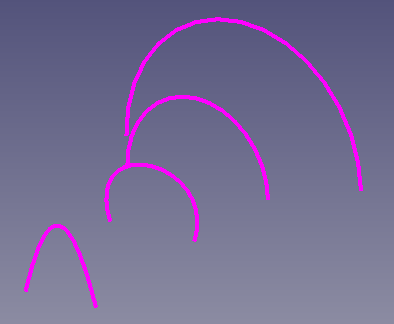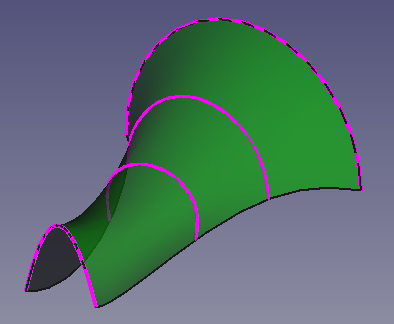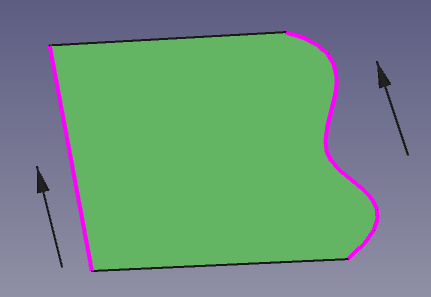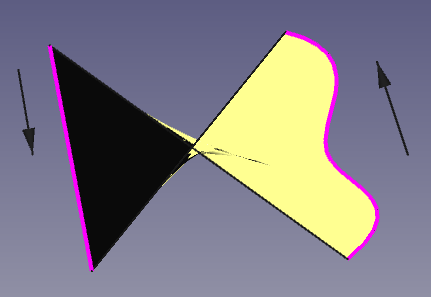Surface Sections
|
|
| Menu location |
|---|
| Surface → Sections |
| Workbenches |
| Surface |
| Default shortcut |
| None |
| Introduced in version |
| 0.19 |
| See also |
| None |
Description
Surface Sections is used to create a surface from edges that represent transversal sections of a surface.
Left: control edges (transversal sections). Right: surface produced from these edges.
Usage
- Make sure you have at least two edges or curves in space. For example, these can be created with tools of the
Draft Workbench or the
Sketcher.
- There are several ways to invoke the tool:
- Press the
Sections... button.
- Select the Surface →
Sections... option from the menu.
- Press the
- Press Add edge.
- Use the pointer to pick the desired edges in the 3D view; a preview of the final shape will be shown after selecting two valid edges.
- Press OK to complete the operation.
Options
- Add edge: press once to start picking edges in the 3D view. Individual lines such as
Draft BSplines and
Sketcher BSplines can be chosen, as well as any edge from solid objects, like those of
PartDesign Bodies and
Part Primitives.
- Remove edge: press once to start picking edges in the 3D view; these must be edges that were previously picked with Add edge.
- Right mouse button: open the context menu and select Remove, or press Del in the keyboard, to remove the currently selected edge in the list.
- Drag: drag the currently selected element in the list in order to change the order in which it will be processed; the list is processed from top to bottom.
- Press Cancel or Esc to abort the current operation.
Properties
A Surface Sections (Surface::Sections class) is derived from the basic Part Feature (Part::Feature class, through the Part::Spline subclass), therefore it shares all the latter's properties.
In addition to the properties described in Part Feature, the Surface Sections has the following properties in the property editor.
Data
Sections
- DataNSections (
LinkSubList): a list of edges that will be used to build the surface.
View
Base
- ViewControl Points (
Bool): it defaults tofalse; if set totrue, it will show an overlay with the control points of the surface.
Twisting of the surface
The shape of the surface depends on the direction of the chosen edges; if edges are selected and the result is a surface that "twists" on itself, one of the edges may need its list of vertices in the reverse order. See the information in GeomFillSurface for a more complete explanation.
Scripting
See also: FreeCAD Scripting Basics.
The Surface Sections tool can be used in macros and from the Python console by adding the Surface::Sections object.
- The edges to be used to define the surface must be assigned as a LinkSubList to the
NSectionsproperty of the object. - All objects with edges need to be computed before they can be used as input for the properties of the Sections object.
import FreeCAD as App
import Draft
doc = App.newDocument()
pl1 = App.Placement()
obj1 = Draft.make_circle(50, placement=pl1, face=False, startangle=0, endangle=180)
pl2 = App.Placement(App.Vector(0, 0, 25), App.Rotation())
obj2 = Draft.make_circle(30, placement=pl2, face=False, startangle=0, endangle=180)
points3 = [App.Vector(18, -10, 50),
App.Vector(12, 10, 50),
App.Vector(-12, 10, 50),
App.Vector(-18, -10, 50)]
obj3 = Draft.make_bspline(points3)
points4 = [App.Vector(15, -20, 100),
App.Vector(0, 6, 100),
App.Vector(-15, -20, 100)]
obj4 = Draft.make_bspline(points4)
doc.recompute()
surf = doc.addObject("Surface::Sections", "Surface")
surf.NSections = [(obj1, "Edge1"),
(obj2, "Edge1"),
(obj3, "Edge1"),
(obj4, "Edge1")]
doc.recompute()
- Getting started
- Installation: Download, Windows, Linux, Mac, Additional components, Docker, AppImage, Ubuntu Snap
- Basics: About FreeCAD, Interface, Mouse navigation, Selection methods, Object name, Preferences, Workbenches, Document structure, Properties, Help FreeCAD, Donate
- Help: Tutorials, Video tutorials
- Workbenches: Std Base, Assembly, BIM, CAM, Draft, FEM, Inspection, Material, Mesh, OpenSCAD, Part, PartDesign, Points, Reverse Engineering, Robot, Sketcher, Spreadsheet, Surface, TechDraw, Test Framework
- Hubs: User hub, Power users hub, Developer hub



